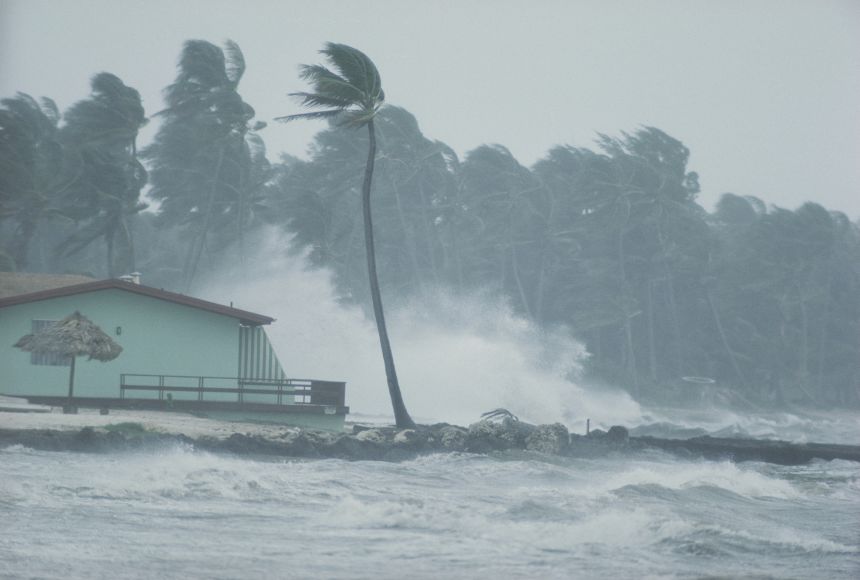The 2005 hurricane season was unlike any other hurricane season before it. There were fifteen named hurricanes—a new record. Four of these hurricanes were classified as Category 5 hurricanes on the Saffir-Simpson scale, which estimates a hurricane's potential severity by using its wind speed and is based on a scale of one to five. A Category 5 hurricane—the most severe—has wind gusts measuring over 251 kilometers per hour (156 miles per hour) causing devastating damage. Hurricane Katrina (August 23–31, 2005), a Category 3 storm, changed New Orleans, Louisiana, forever, killing over 1,800 people and becoming the costliest hurricane in United State history, causing 162 billion dollars in damages. Just a couple of months later, Hurricane Wilma (October 15–25, 2005) was the strongest hurricane ever recorded with sustained winds of 280 kilometers per hour (175 miles per hour). That same year, peer-reviewed scientific journals published two scientific papers that claimed that there was evidence linking increases in sea-surface temperatures around the world to the number, strength, and destructive ability of hurricanes over the last thirty years.
What is a hurricane and how does it form?
A hurricane is a tropical storm formed in the Atlantic Ocean, Caribbean Sea, Gulf of Mexico, or Pacific Ocean. To form, hurricanes need warm temperatures; ocean water above 26.5 degrees Celsius (80 degrees Fahrenheit) is considered ideal. Warm ocean waters provide fuel for the tropical storm. As warm ocean water evaporates into the air, it rises. At some point, the water vapor cools and condenses, forming precipitation. This cycle repeats, while inside the storm clouds, wind speeds increase. Once the winds reach a speed of 64 knots (119 kilometers per hours; 74 miles per hour), the severe storm is considered to be a hurricane. The winds cause these storms to spin in a circular motion (counter-clockwise in the Northern Hemisphere and clockwise in the Southern Hemisphere). The heavy rains and fierce winds that accompany a hurricane can have devastating effects on life and property.
What does climate change have to do with hurricane formation?
Since warm ocean waters are essential to form and maintain a hurricane, scientists wondered if there was a connection between warmer ocean temperatures and an increase in hurricane frequency and strength. Scientists have been examining the effect of climate change on sea-surface temperatures around the globe, using records from as far back as 1880. The data shows a significant surge in global sea-surface temperatures. Researchers suspected that climate change was playing a part in these warmer waters but they needed to find proof.
Ethan Gutmann, a project scientist at the National Center for Atmospheric Research, found a way to show how climate change would affect hurricanes. Gutmann ran a computerized simulation of twenty-two named hurricanes that occurred between 2001 to 2013. In the simulation, he changed the temperature, humidity, wind speed, and direction to mimic the conditions expected in the future as a result of climate change. How did the hurricanes respond to climate change? The hurricanes all had more rain and, on average, stronger wind speeds, but each hurricane reacted differently to climate change.
While some scientists believe there is enough evidence to say that climate change caused by human activities is the reason for the increase in the number and strength of recent hurricane seasons, other researchers are still unsure that climate change is the only cause.
Since hurricanes form without any help from humans, scientists know that there could be other things in nature influencing their formation and strength that have nothing to do with climate change. One example is an El Niño or La Niña event. El Niño and La Niña events cause unusual warming or cooling of the ocean waters near the equator, affecting weather patterns around the world.
What is the future of hurricane seasons?
Some scientists think that having an active hurricane season with many strong storms could make the following year’s hurricane season much calmer. A large, powerful hurricane takes a lot of heat from the ocean to form and grow. This means that after a hurricane, the ocean waters are much colder and it will take more time for the water to heat up enough to fuel other hurricanes.
In one study, researchers discovered that the amount of rainfall from Hurricane Harvey in 2017 likely matches the amount of evaporation and heat loss in the ocean after Harvey. This gives scientists another tool to use in examining how much heat hurricanes remove from the ocean. Meteorologists and atmospheric scientists continue to study possible links between climate change and the frequency and intensity of hurricanes.

